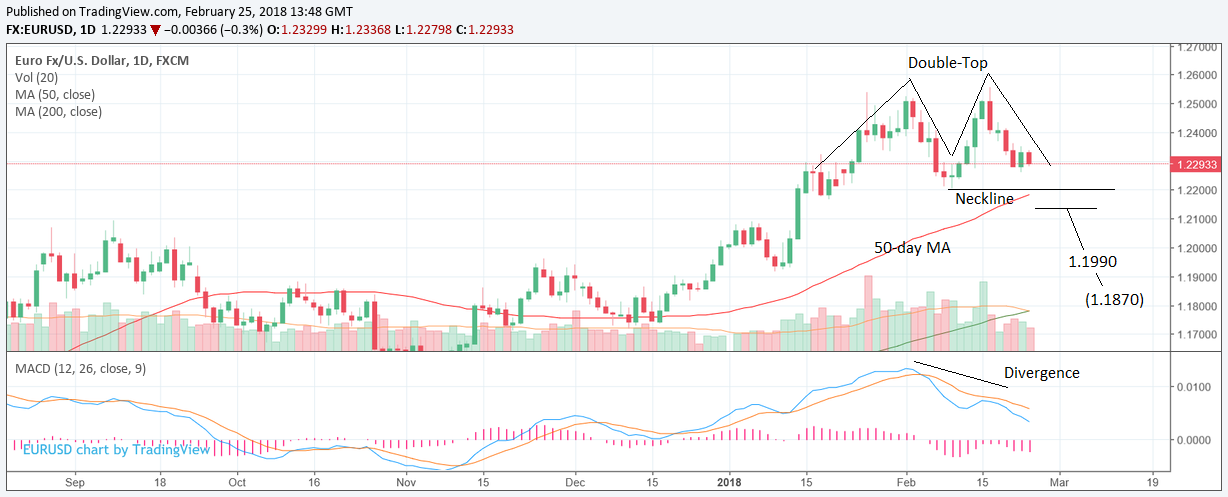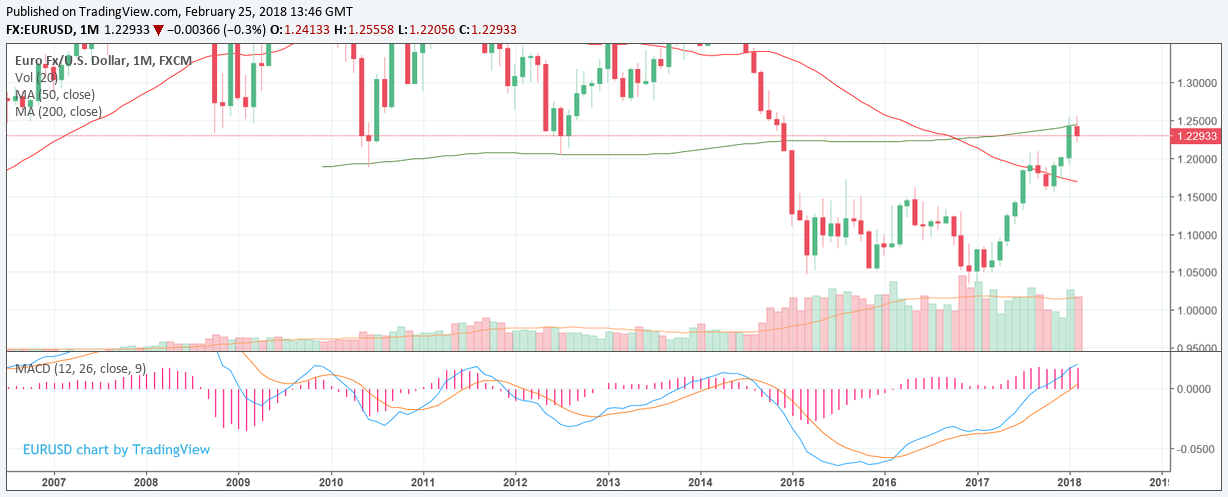Euro-to-Dollar Rate Forecast for the Week Ahead

© kasto, Adobe Stock
The EUR/USD exchange rate is looking increasingly vulnerable to breaking down despite its long-term uptrend, is this the final bend at the end of the trend?
The US Dollar's rebound continues and sees the EUR/USD extending its sell-off to a major make-or-break level at the 1.2200 February 9 lows.
The exchange rate has formed a distinctive 'M' shaped topping pattern (see below) called a double top which has bearish implications for the pair.
A break below the trigger point or 'neckline' as technical analysts call it, at 1.2206 (current market level is 1.2293) would almost certainly see the pair decline to below the 1.2000 level.
Such a break would see the exchange rate fall to a potential eventual target at 1.1870, calculated by taking the height of the pattern and extrapolating it lower - the usual method for forecasting from double-tops.
A more conservative target lies at 1.1990, which is the golden ratio (or 0.618) of the height - the golden ratio is an ancient mathematical constant which tends to have significance in financial markets.
Until there is a break below the neckline, however, there is still a possibility the pair will eventually resume its more established uptrend, but such a move would require a decisive break above the current 1.2557 highs for the purposes of re-validation.
The longer-term monthly chart shows how the uptrend ran into difficulties when it touched the 200-month moving average (green line) at 1.2450.
Major moving averages often act as obstacles to the trend - note, for example, how the exchange rate pulled back after encountering the 50-month MA (red line) at 1.1870 last August.
The location of the 200-month at the highs of the trend capping gains, adds further evidence to support the bearish short-term forecast for the pair.
Get up to 5% more foreign exchange by using a specialist provider to get closer to the real market rate and avoid the gaping spreads charged by your bank when providing currency. Learn more here.
Data and Events to Watch for the Euro
It is a big week ahead for politics in the European Union starting with the German CDU party's vote on whether or not form a grand coalition on Monday. This is Merkel's party so it is quite important they back a deal. If they vote against it is is expected to send the Euro lower.
Then on Sunday the 4th of March it is the turn of the SPD to vote on the same question. Also on ther 4th Italians will go to the polls to vote in their general election. No outright winner is expected at the moment but if 5-star start to forge ahead in the run up to the vote the Euro may take some flack, however, it is unlikely they will recieve enough votes to push for an Italexit and threaten the unity of the Euro-area.
Nevertheless the considerable risk posed by these events could spell weakness for the Euro in the run up to the elections even if it is because of traders standing aside.
“It would be understandable if the euro weakened modestly in the run up,” says Lee Hardman, a currency analyst at MUFG. “Market participants currently appear relatively relaxed over the outcome from both votes. Demand for euro downside protection in the options market has been relatively modest compared to in the urn up to last year’s French election.”
On the hard data front the main release in the coming week is Eurozone inflation data for February, out on Wednesday at 10.00 GMT, and expected to slow slightly to 1.2% from 1.3% a year ago.
Core CPI out at the same time is expected to come out at 1.0% - the same as a year ago.
Higher inflation tends to push up interest rates which tend to push up the Euro, because higher interestb rates expectations increase inbound foreign capital flows drawn by the promise of higher returns.
Therefore the inflation data on Wednesday may well be key for the Euro.
Another major release for the Euro in the week ahead will be January employment data which is forecast to come out at 8.6% from 8.7% in December. A fall in unemployment is positive for the single currency as it increases inflation pressures.
Data and Events to Watch for the Dollar
One of the main events for the Dollar in the week ahead is the appearance of the new Governor of the Federal Reserve (Fed) Jerome Powell in front of the House of Representatives Financial Services Committee (Wednesday) and the Senate Committee on Banking, Housing, and Urban Affairs (Thursday).
Since this will be his first public appearance as the new Governor analysts are expecting Powell to naturally comment on monetary policy.
"Given that the Governor has said very little about his plans to take policy forward, it is possible he could use these hearings as a platform to bridge rate expectations before his first FOMC meeting as its chair on March 20-21," says Investec analysts George Brown and Victoria Clarke.
After the government's decision to expand fiscal timulus via increased spending and tax cuts most economists expect inflation to rise more rapidly than previously and the Fed to be forced to raise interest rates more aggressively, with some now even expecting four rate hikes in 2018, (from three previously).
If Powell is seen as supporting a more hawkish outlook - hawkish means in favour of higher interest rates - the Dollar will rise, as higher interest rates are positive for the currency, because they attract greater inflows of foreign capital drawn by the higher returns on offer.
Another major release in the week ahead is Personal Consumption Expenditure (PCE), which is the Fed's prefered gauge of inflation.
Core PCE in January, is out at 13.30 GMT on Thursday, March 1, and is forecast to remain at 1.5% compared to the same time a year ago and 0.3% (up from 0.2%) compared to the previous month; a higher result would support the Dollar.
Also of import for the Dollar in the week ahead is the second estimate of GDP data for the 4th quarter, which is expected to show a marginally lower 2.5% quarter-on-quarter (qoq) rise when it is released on Wednesday, February 28, at 13.30 GMT.
A major gauge of growth and the health of the economy in the form of ISM Manufacturing PMI, is out on Thursday, March 1 at 15.00 GMT.
This highly regarded survey conducted by the Instiute of Supply Managers (ISM) asks questions of key managers in manufacturing and tends to be a fairly reliable indicator of future trends.
ISM Manufacturing is forecast to come out at an already fairly high 59.0 in February from 59.1 previously - it could well be market moving with higher result than expected lifting the Dollar and vice versa for a lower result.
Get up to 5% more foreign exchange by using a specialist provider to get closer to the real market rate and avoid the gaping spreads charged by your bank when providing currency. Learn more here.






